Social Determinants of Health and Heart Disease in Older Australians
VerifiedAdded on 2022/10/12
|8
|2131
|107
Report
AI Summary
This report delves into the critical issue of cardiovascular disease (CVD) prevalence among the older population in Australia, a significant public health concern accounting for a substantial portion of the national disease burden. The study focuses on the social determinants of health (SDH) contributing to heart disease in this demographic, highlighting factors like lifestyle choices (smoking, alcohol consumption, physical activity), socioeconomic status, stress, and social isolation. It underscores the importance of adopting interventional approaches to mitigate these determinants, emphasizing the role of public health strategies, education campaigns, and community-based programs. The report references the Ottawa Charter for Health Promotion and explores how interventions such as screening, lifestyle modification programs, and community engagement can reduce the burden of heart disease, ultimately aiming to improve the cardiovascular health of older Australians.
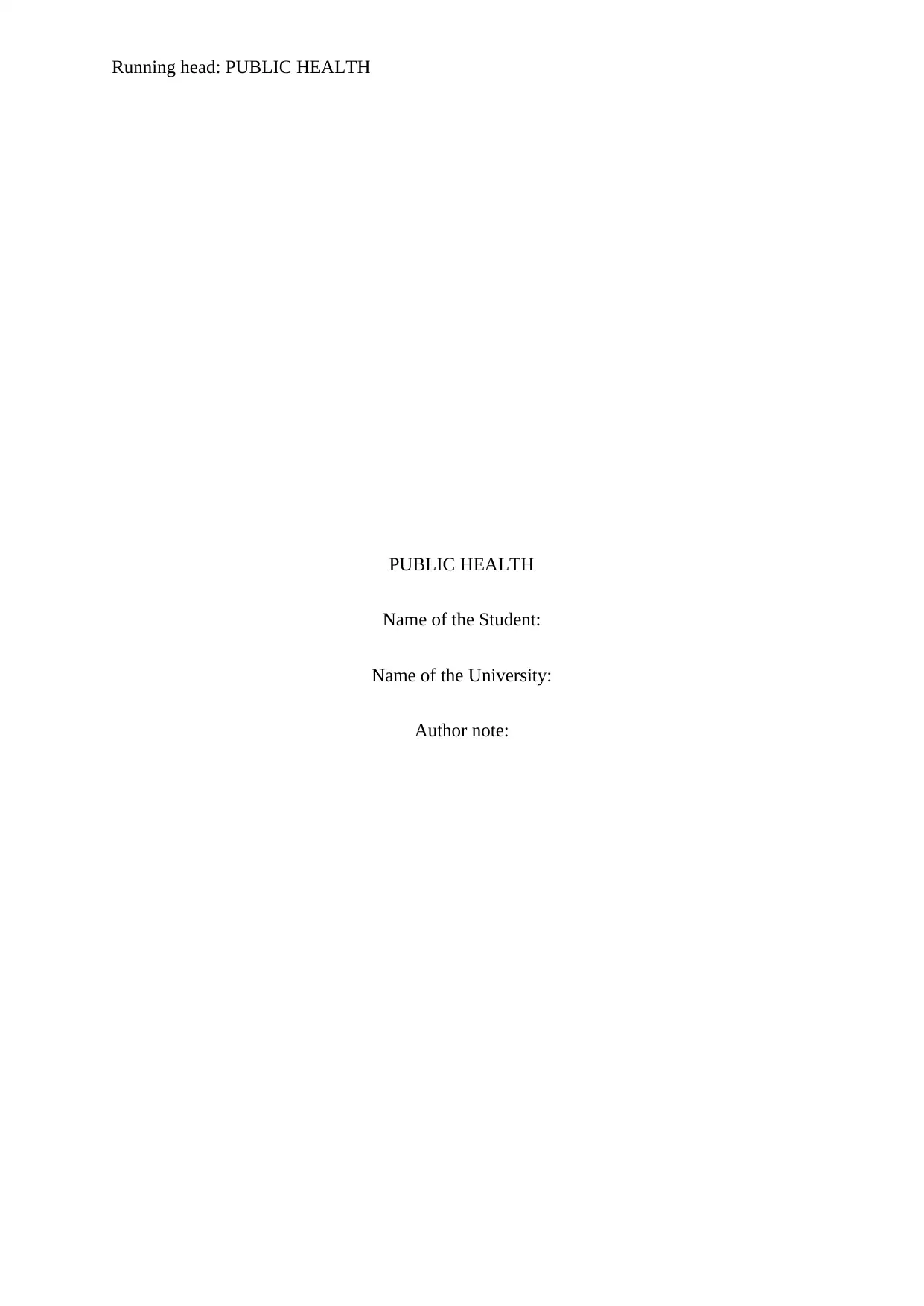
Running head: PUBLIC HEALTH
PUBLIC HEALTH
Name of the Student:
Name of the University:
Author note:
PUBLIC HEALTH
Name of the Student:
Name of the University:
Author note:
Paraphrase This Document
Need a fresh take? Get an instant paraphrase of this document with our AI Paraphraser
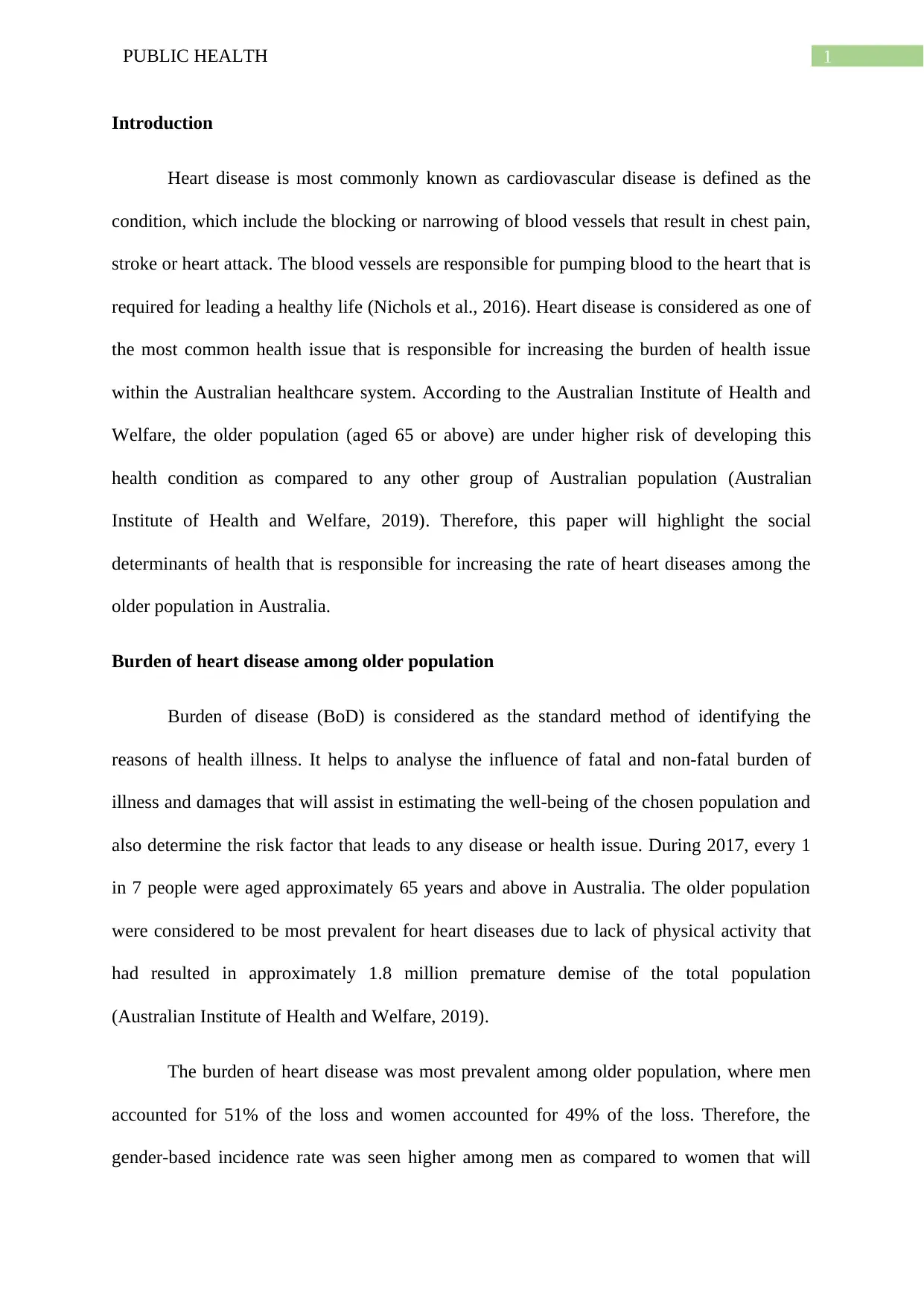
1PUBLIC HEALTH
Introduction
Heart disease is most commonly known as cardiovascular disease is defined as the
condition, which include the blocking or narrowing of blood vessels that result in chest pain,
stroke or heart attack. The blood vessels are responsible for pumping blood to the heart that is
required for leading a healthy life (Nichols et al., 2016). Heart disease is considered as one of
the most common health issue that is responsible for increasing the burden of health issue
within the Australian healthcare system. According to the Australian Institute of Health and
Welfare, the older population (aged 65 or above) are under higher risk of developing this
health condition as compared to any other group of Australian population (Australian
Institute of Health and Welfare, 2019). Therefore, this paper will highlight the social
determinants of health that is responsible for increasing the rate of heart diseases among the
older population in Australia.
Burden of heart disease among older population
Burden of disease (BoD) is considered as the standard method of identifying the
reasons of health illness. It helps to analyse the influence of fatal and non-fatal burden of
illness and damages that will assist in estimating the well-being of the chosen population and
also determine the risk factor that leads to any disease or health issue. During 2017, every 1
in 7 people were aged approximately 65 years and above in Australia. The older population
were considered to be most prevalent for heart diseases due to lack of physical activity that
had resulted in approximately 1.8 million premature demise of the total population
(Australian Institute of Health and Welfare, 2019).
The burden of heart disease was most prevalent among older population, where men
accounted for 51% of the loss and women accounted for 49% of the loss. Therefore, the
gender-based incidence rate was seen higher among men as compared to women that will
Introduction
Heart disease is most commonly known as cardiovascular disease is defined as the
condition, which include the blocking or narrowing of blood vessels that result in chest pain,
stroke or heart attack. The blood vessels are responsible for pumping blood to the heart that is
required for leading a healthy life (Nichols et al., 2016). Heart disease is considered as one of
the most common health issue that is responsible for increasing the burden of health issue
within the Australian healthcare system. According to the Australian Institute of Health and
Welfare, the older population (aged 65 or above) are under higher risk of developing this
health condition as compared to any other group of Australian population (Australian
Institute of Health and Welfare, 2019). Therefore, this paper will highlight the social
determinants of health that is responsible for increasing the rate of heart diseases among the
older population in Australia.
Burden of heart disease among older population
Burden of disease (BoD) is considered as the standard method of identifying the
reasons of health illness. It helps to analyse the influence of fatal and non-fatal burden of
illness and damages that will assist in estimating the well-being of the chosen population and
also determine the risk factor that leads to any disease or health issue. During 2017, every 1
in 7 people were aged approximately 65 years and above in Australia. The older population
were considered to be most prevalent for heart diseases due to lack of physical activity that
had resulted in approximately 1.8 million premature demise of the total population
(Australian Institute of Health and Welfare, 2019).
The burden of heart disease was most prevalent among older population, where men
accounted for 51% of the loss and women accounted for 49% of the loss. Therefore, the
gender-based incidence rate was seen higher among men as compared to women that will
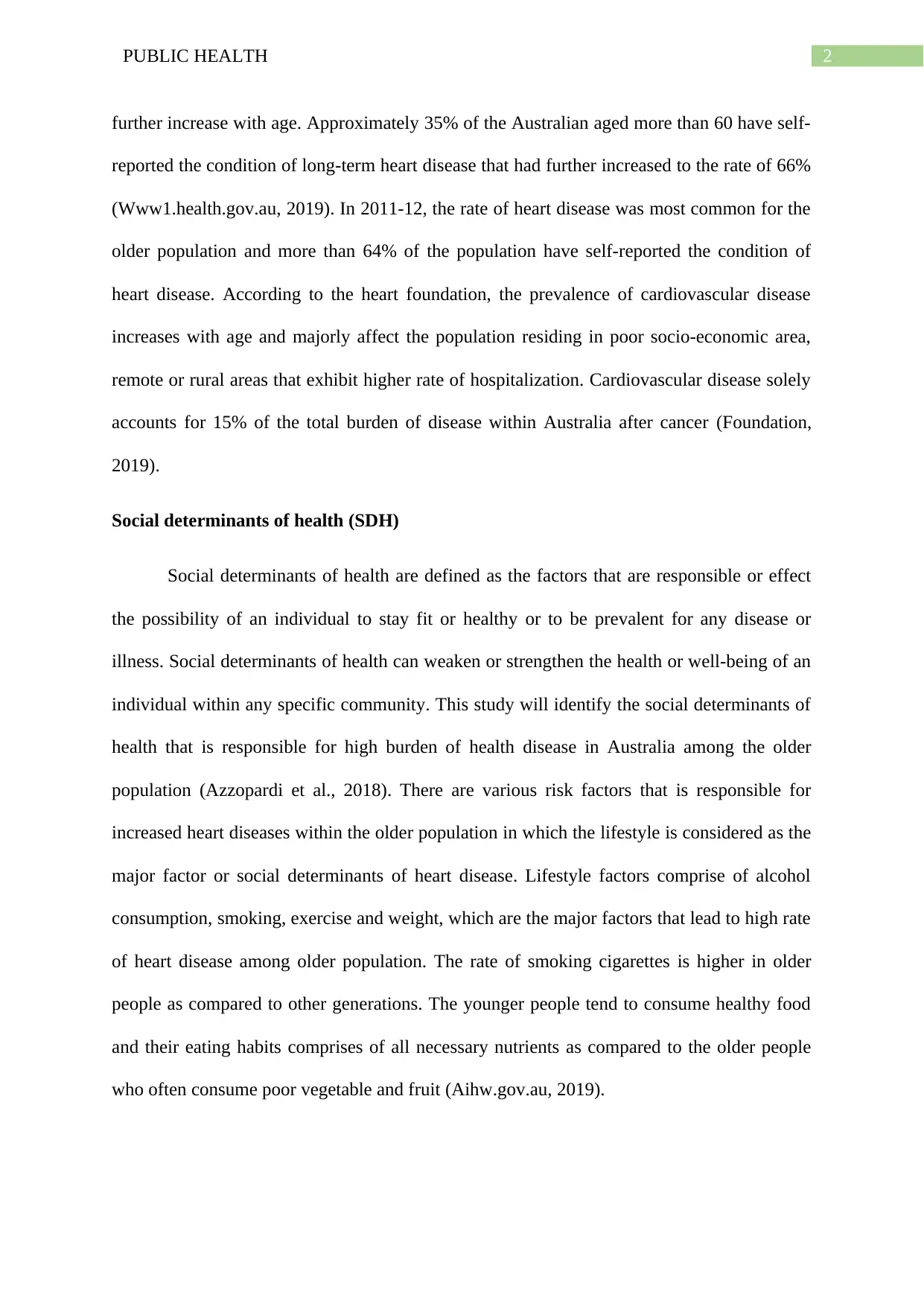
2PUBLIC HEALTH
further increase with age. Approximately 35% of the Australian aged more than 60 have self-
reported the condition of long-term heart disease that had further increased to the rate of 66%
(Www1.health.gov.au, 2019). In 2011-12, the rate of heart disease was most common for the
older population and more than 64% of the population have self-reported the condition of
heart disease. According to the heart foundation, the prevalence of cardiovascular disease
increases with age and majorly affect the population residing in poor socio-economic area,
remote or rural areas that exhibit higher rate of hospitalization. Cardiovascular disease solely
accounts for 15% of the total burden of disease within Australia after cancer (Foundation,
2019).
Social determinants of health (SDH)
Social determinants of health are defined as the factors that are responsible or effect
the possibility of an individual to stay fit or healthy or to be prevalent for any disease or
illness. Social determinants of health can weaken or strengthen the health or well-being of an
individual within any specific community. This study will identify the social determinants of
health that is responsible for high burden of health disease in Australia among the older
population (Azzopardi et al., 2018). There are various risk factors that is responsible for
increased heart diseases within the older population in which the lifestyle is considered as the
major factor or social determinants of heart disease. Lifestyle factors comprise of alcohol
consumption, smoking, exercise and weight, which are the major factors that lead to high rate
of heart disease among older population. The rate of smoking cigarettes is higher in older
people as compared to other generations. The younger people tend to consume healthy food
and their eating habits comprises of all necessary nutrients as compared to the older people
who often consume poor vegetable and fruit (Aihw.gov.au, 2019).
further increase with age. Approximately 35% of the Australian aged more than 60 have self-
reported the condition of long-term heart disease that had further increased to the rate of 66%
(Www1.health.gov.au, 2019). In 2011-12, the rate of heart disease was most common for the
older population and more than 64% of the population have self-reported the condition of
heart disease. According to the heart foundation, the prevalence of cardiovascular disease
increases with age and majorly affect the population residing in poor socio-economic area,
remote or rural areas that exhibit higher rate of hospitalization. Cardiovascular disease solely
accounts for 15% of the total burden of disease within Australia after cancer (Foundation,
2019).
Social determinants of health (SDH)
Social determinants of health are defined as the factors that are responsible or effect
the possibility of an individual to stay fit or healthy or to be prevalent for any disease or
illness. Social determinants of health can weaken or strengthen the health or well-being of an
individual within any specific community. This study will identify the social determinants of
health that is responsible for high burden of health disease in Australia among the older
population (Azzopardi et al., 2018). There are various risk factors that is responsible for
increased heart diseases within the older population in which the lifestyle is considered as the
major factor or social determinants of heart disease. Lifestyle factors comprise of alcohol
consumption, smoking, exercise and weight, which are the major factors that lead to high rate
of heart disease among older population. The rate of smoking cigarettes is higher in older
people as compared to other generations. The younger people tend to consume healthy food
and their eating habits comprises of all necessary nutrients as compared to the older people
who often consume poor vegetable and fruit (Aihw.gov.au, 2019).
⊘ This is a preview!⊘
Do you want full access?
Subscribe today to unlock all pages.

Trusted by 1+ million students worldwide
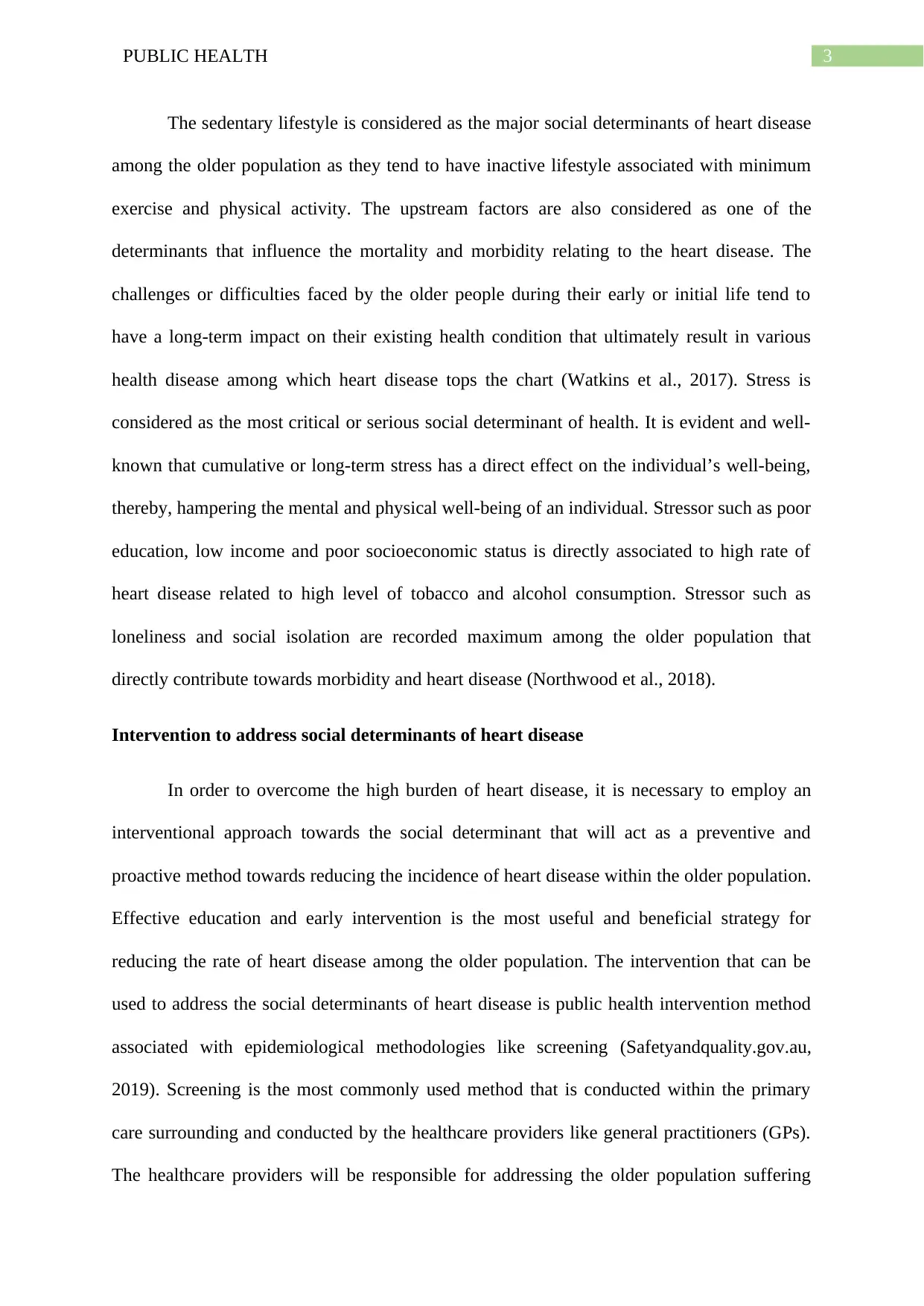
3PUBLIC HEALTH
The sedentary lifestyle is considered as the major social determinants of heart disease
among the older population as they tend to have inactive lifestyle associated with minimum
exercise and physical activity. The upstream factors are also considered as one of the
determinants that influence the mortality and morbidity relating to the heart disease. The
challenges or difficulties faced by the older people during their early or initial life tend to
have a long-term impact on their existing health condition that ultimately result in various
health disease among which heart disease tops the chart (Watkins et al., 2017). Stress is
considered as the most critical or serious social determinant of health. It is evident and well-
known that cumulative or long-term stress has a direct effect on the individual’s well-being,
thereby, hampering the mental and physical well-being of an individual. Stressor such as poor
education, low income and poor socioeconomic status is directly associated to high rate of
heart disease related to high level of tobacco and alcohol consumption. Stressor such as
loneliness and social isolation are recorded maximum among the older population that
directly contribute towards morbidity and heart disease (Northwood et al., 2018).
Intervention to address social determinants of heart disease
In order to overcome the high burden of heart disease, it is necessary to employ an
interventional approach towards the social determinant that will act as a preventive and
proactive method towards reducing the incidence of heart disease within the older population.
Effective education and early intervention is the most useful and beneficial strategy for
reducing the rate of heart disease among the older population. The intervention that can be
used to address the social determinants of heart disease is public health intervention method
associated with epidemiological methodologies like screening (Safetyandquality.gov.au,
2019). Screening is the most commonly used method that is conducted within the primary
care surrounding and conducted by the healthcare providers like general practitioners (GPs).
The healthcare providers will be responsible for addressing the older population suffering
The sedentary lifestyle is considered as the major social determinants of heart disease
among the older population as they tend to have inactive lifestyle associated with minimum
exercise and physical activity. The upstream factors are also considered as one of the
determinants that influence the mortality and morbidity relating to the heart disease. The
challenges or difficulties faced by the older people during their early or initial life tend to
have a long-term impact on their existing health condition that ultimately result in various
health disease among which heart disease tops the chart (Watkins et al., 2017). Stress is
considered as the most critical or serious social determinant of health. It is evident and well-
known that cumulative or long-term stress has a direct effect on the individual’s well-being,
thereby, hampering the mental and physical well-being of an individual. Stressor such as poor
education, low income and poor socioeconomic status is directly associated to high rate of
heart disease related to high level of tobacco and alcohol consumption. Stressor such as
loneliness and social isolation are recorded maximum among the older population that
directly contribute towards morbidity and heart disease (Northwood et al., 2018).
Intervention to address social determinants of heart disease
In order to overcome the high burden of heart disease, it is necessary to employ an
interventional approach towards the social determinant that will act as a preventive and
proactive method towards reducing the incidence of heart disease within the older population.
Effective education and early intervention is the most useful and beneficial strategy for
reducing the rate of heart disease among the older population. The intervention that can be
used to address the social determinants of heart disease is public health intervention method
associated with epidemiological methodologies like screening (Safetyandquality.gov.au,
2019). Screening is the most commonly used method that is conducted within the primary
care surrounding and conducted by the healthcare providers like general practitioners (GPs).
The healthcare providers will be responsible for addressing the older population suffering
Paraphrase This Document
Need a fresh take? Get an instant paraphrase of this document with our AI Paraphraser
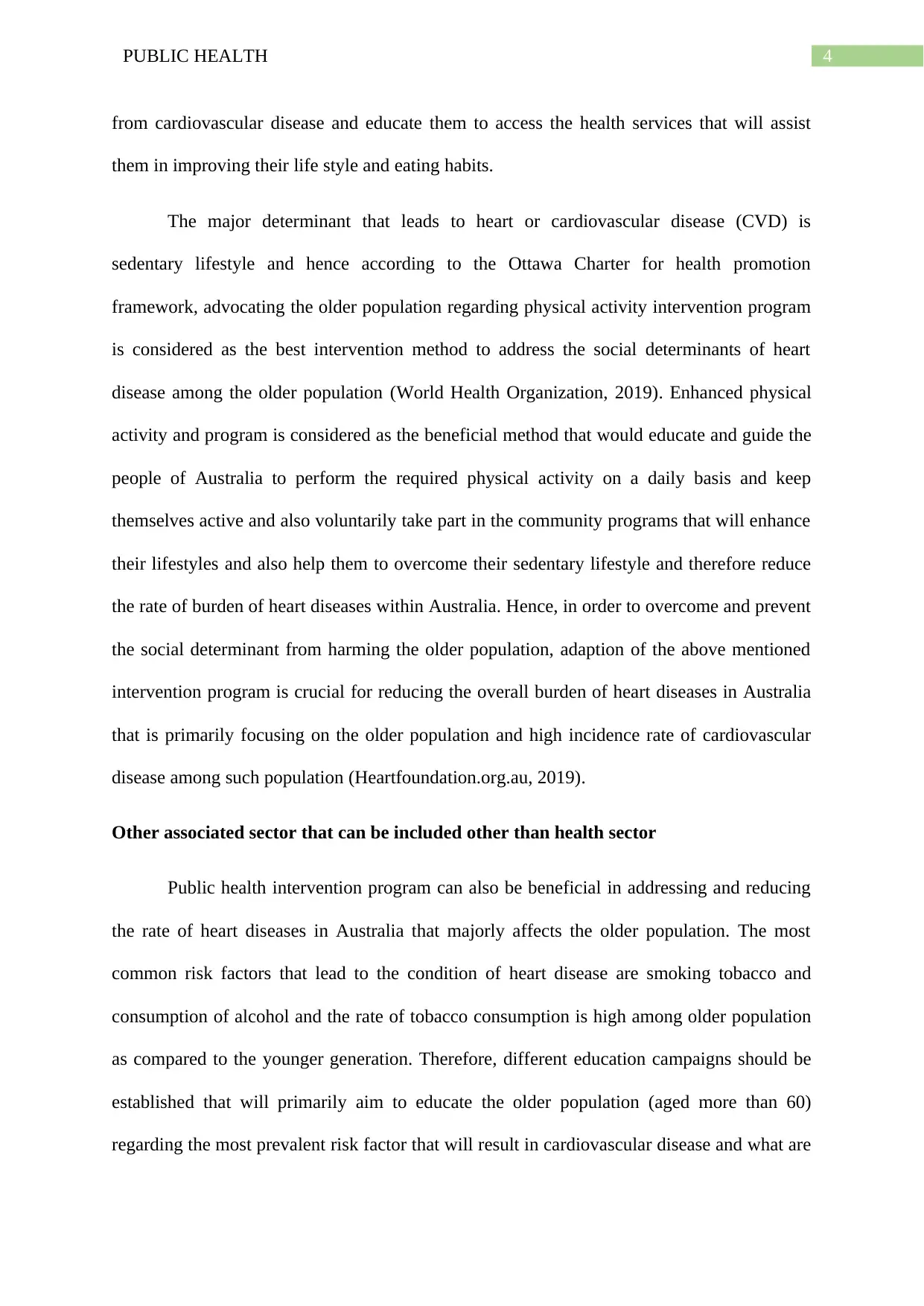
4PUBLIC HEALTH
from cardiovascular disease and educate them to access the health services that will assist
them in improving their life style and eating habits.
The major determinant that leads to heart or cardiovascular disease (CVD) is
sedentary lifestyle and hence according to the Ottawa Charter for health promotion
framework, advocating the older population regarding physical activity intervention program
is considered as the best intervention method to address the social determinants of heart
disease among the older population (World Health Organization, 2019). Enhanced physical
activity and program is considered as the beneficial method that would educate and guide the
people of Australia to perform the required physical activity on a daily basis and keep
themselves active and also voluntarily take part in the community programs that will enhance
their lifestyles and also help them to overcome their sedentary lifestyle and therefore reduce
the rate of burden of heart diseases within Australia. Hence, in order to overcome and prevent
the social determinant from harming the older population, adaption of the above mentioned
intervention program is crucial for reducing the overall burden of heart diseases in Australia
that is primarily focusing on the older population and high incidence rate of cardiovascular
disease among such population (Heartfoundation.org.au, 2019).
Other associated sector that can be included other than health sector
Public health intervention program can also be beneficial in addressing and reducing
the rate of heart diseases in Australia that majorly affects the older population. The most
common risk factors that lead to the condition of heart disease are smoking tobacco and
consumption of alcohol and the rate of tobacco consumption is high among older population
as compared to the younger generation. Therefore, different education campaigns should be
established that will primarily aim to educate the older population (aged more than 60)
regarding the most prevalent risk factor that will result in cardiovascular disease and what are
from cardiovascular disease and educate them to access the health services that will assist
them in improving their life style and eating habits.
The major determinant that leads to heart or cardiovascular disease (CVD) is
sedentary lifestyle and hence according to the Ottawa Charter for health promotion
framework, advocating the older population regarding physical activity intervention program
is considered as the best intervention method to address the social determinants of heart
disease among the older population (World Health Organization, 2019). Enhanced physical
activity and program is considered as the beneficial method that would educate and guide the
people of Australia to perform the required physical activity on a daily basis and keep
themselves active and also voluntarily take part in the community programs that will enhance
their lifestyles and also help them to overcome their sedentary lifestyle and therefore reduce
the rate of burden of heart diseases within Australia. Hence, in order to overcome and prevent
the social determinant from harming the older population, adaption of the above mentioned
intervention program is crucial for reducing the overall burden of heart diseases in Australia
that is primarily focusing on the older population and high incidence rate of cardiovascular
disease among such population (Heartfoundation.org.au, 2019).
Other associated sector that can be included other than health sector
Public health intervention program can also be beneficial in addressing and reducing
the rate of heart diseases in Australia that majorly affects the older population. The most
common risk factors that lead to the condition of heart disease are smoking tobacco and
consumption of alcohol and the rate of tobacco consumption is high among older population
as compared to the younger generation. Therefore, different education campaigns should be
established that will primarily aim to educate the older population (aged more than 60)
regarding the most prevalent risk factor that will result in cardiovascular disease and what are
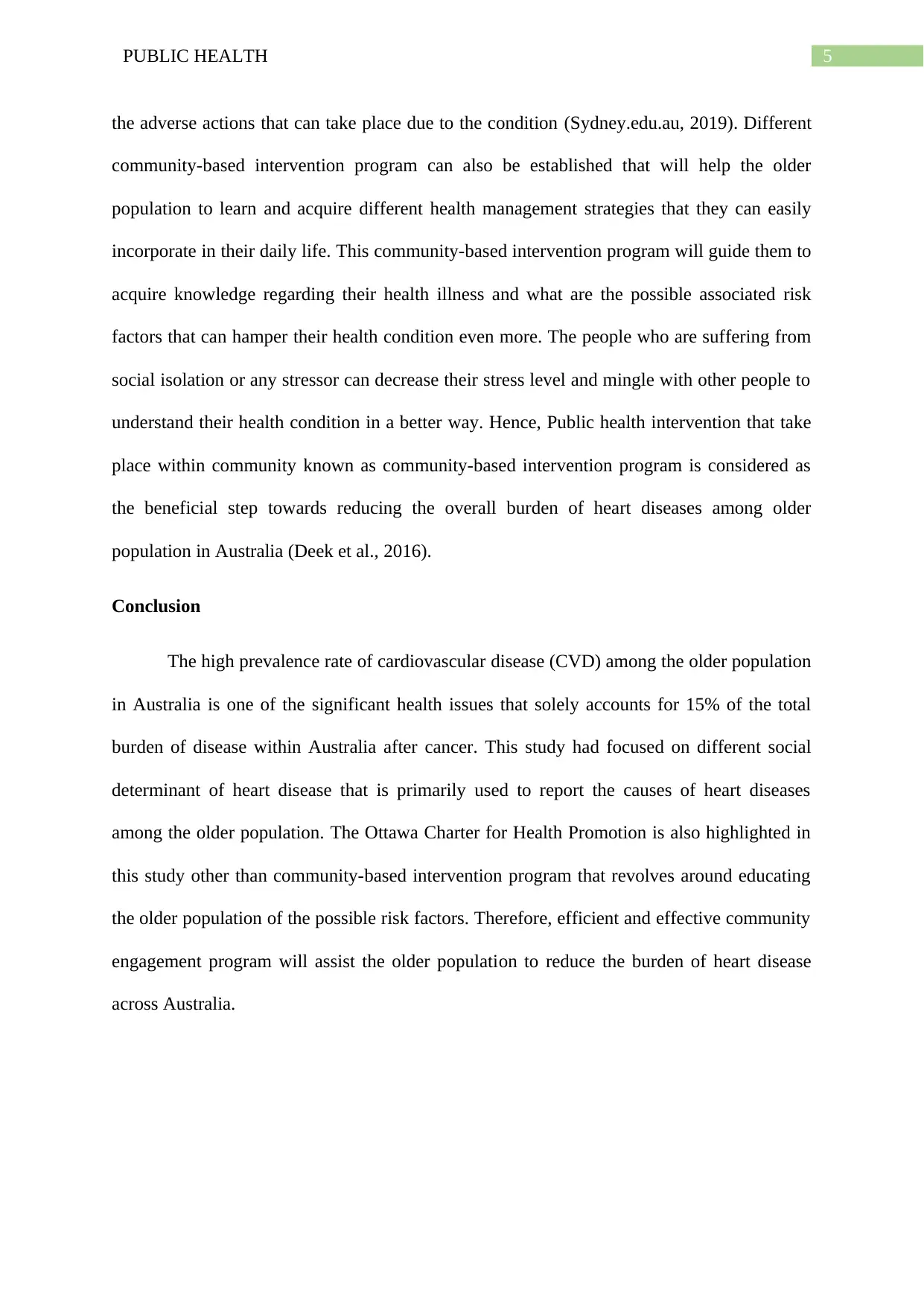
5PUBLIC HEALTH
the adverse actions that can take place due to the condition (Sydney.edu.au, 2019). Different
community-based intervention program can also be established that will help the older
population to learn and acquire different health management strategies that they can easily
incorporate in their daily life. This community-based intervention program will guide them to
acquire knowledge regarding their health illness and what are the possible associated risk
factors that can hamper their health condition even more. The people who are suffering from
social isolation or any stressor can decrease their stress level and mingle with other people to
understand their health condition in a better way. Hence, Public health intervention that take
place within community known as community-based intervention program is considered as
the beneficial step towards reducing the overall burden of heart diseases among older
population in Australia (Deek et al., 2016).
Conclusion
The high prevalence rate of cardiovascular disease (CVD) among the older population
in Australia is one of the significant health issues that solely accounts for 15% of the total
burden of disease within Australia after cancer. This study had focused on different social
determinant of heart disease that is primarily used to report the causes of heart diseases
among the older population. The Ottawa Charter for Health Promotion is also highlighted in
this study other than community-based intervention program that revolves around educating
the older population of the possible risk factors. Therefore, efficient and effective community
engagement program will assist the older population to reduce the burden of heart disease
across Australia.
the adverse actions that can take place due to the condition (Sydney.edu.au, 2019). Different
community-based intervention program can also be established that will help the older
population to learn and acquire different health management strategies that they can easily
incorporate in their daily life. This community-based intervention program will guide them to
acquire knowledge regarding their health illness and what are the possible associated risk
factors that can hamper their health condition even more. The people who are suffering from
social isolation or any stressor can decrease their stress level and mingle with other people to
understand their health condition in a better way. Hence, Public health intervention that take
place within community known as community-based intervention program is considered as
the beneficial step towards reducing the overall burden of heart diseases among older
population in Australia (Deek et al., 2016).
Conclusion
The high prevalence rate of cardiovascular disease (CVD) among the older population
in Australia is one of the significant health issues that solely accounts for 15% of the total
burden of disease within Australia after cancer. This study had focused on different social
determinant of heart disease that is primarily used to report the causes of heart diseases
among the older population. The Ottawa Charter for Health Promotion is also highlighted in
this study other than community-based intervention program that revolves around educating
the older population of the possible risk factors. Therefore, efficient and effective community
engagement program will assist the older population to reduce the burden of heart disease
across Australia.
⊘ This is a preview!⊘
Do you want full access?
Subscribe today to unlock all pages.

Trusted by 1+ million students worldwide
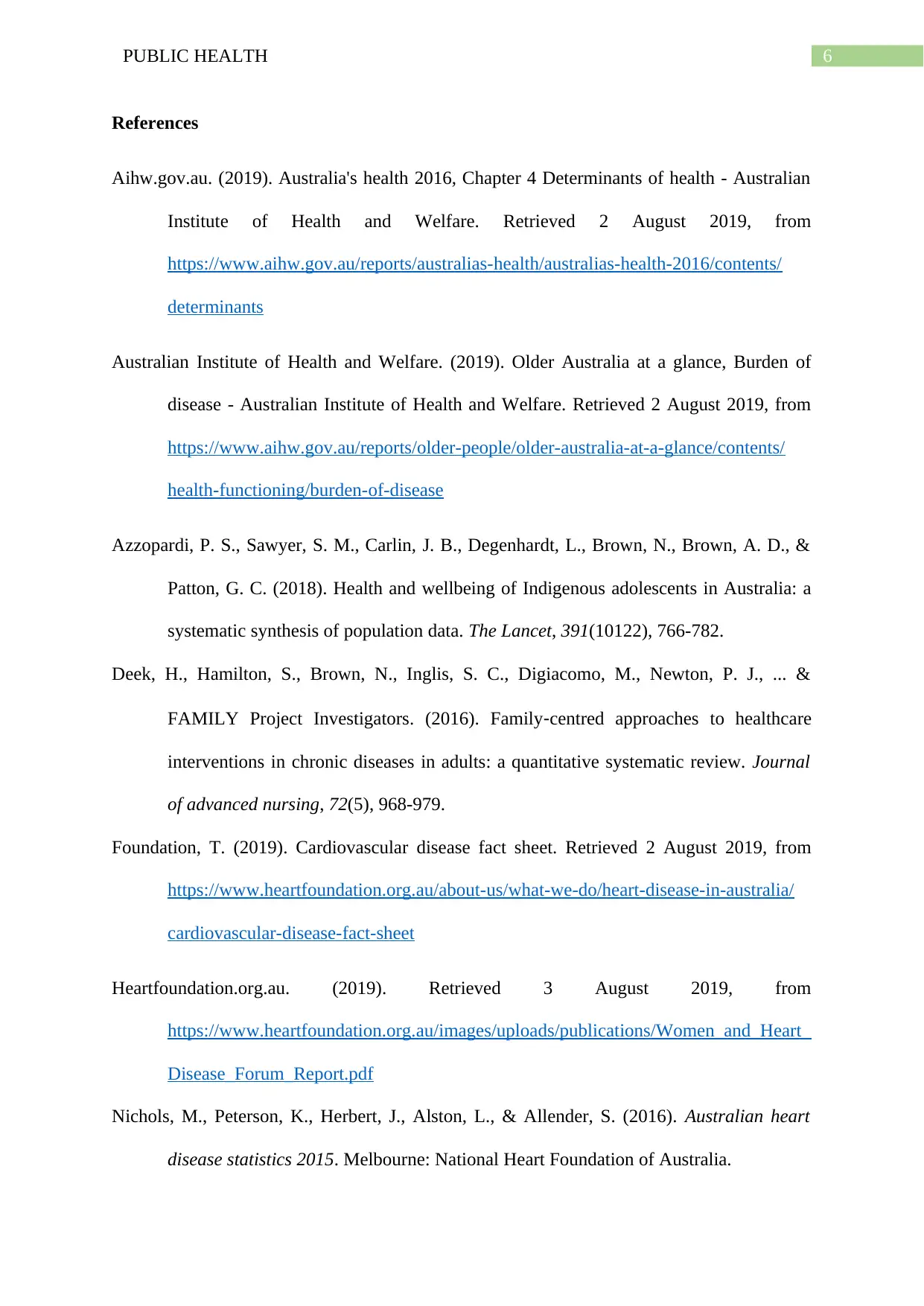
6PUBLIC HEALTH
References
Aihw.gov.au. (2019). Australia's health 2016, Chapter 4 Determinants of health - Australian
Institute of Health and Welfare. Retrieved 2 August 2019, from
https://www.aihw.gov.au/reports/australias-health/australias-health-2016/contents/
determinants
Australian Institute of Health and Welfare. (2019). Older Australia at a glance, Burden of
disease - Australian Institute of Health and Welfare. Retrieved 2 August 2019, from
https://www.aihw.gov.au/reports/older-people/older-australia-at-a-glance/contents/
health-functioning/burden-of-disease
Azzopardi, P. S., Sawyer, S. M., Carlin, J. B., Degenhardt, L., Brown, N., Brown, A. D., &
Patton, G. C. (2018). Health and wellbeing of Indigenous adolescents in Australia: a
systematic synthesis of population data. The Lancet, 391(10122), 766-782.
Deek, H., Hamilton, S., Brown, N., Inglis, S. C., Digiacomo, M., Newton, P. J., ... &
FAMILY Project Investigators. (2016). Family‐centred approaches to healthcare
interventions in chronic diseases in adults: a quantitative systematic review. Journal
of advanced nursing, 72(5), 968-979.
Foundation, T. (2019). Cardiovascular disease fact sheet. Retrieved 2 August 2019, from
https://www.heartfoundation.org.au/about-us/what-we-do/heart-disease-in-australia/
cardiovascular-disease-fact-sheet
Heartfoundation.org.au. (2019). Retrieved 3 August 2019, from
https://www.heartfoundation.org.au/images/uploads/publications/Women_and_Heart_
Disease_Forum_Report.pdf
Nichols, M., Peterson, K., Herbert, J., Alston, L., & Allender, S. (2016). Australian heart
disease statistics 2015. Melbourne: National Heart Foundation of Australia.
References
Aihw.gov.au. (2019). Australia's health 2016, Chapter 4 Determinants of health - Australian
Institute of Health and Welfare. Retrieved 2 August 2019, from
https://www.aihw.gov.au/reports/australias-health/australias-health-2016/contents/
determinants
Australian Institute of Health and Welfare. (2019). Older Australia at a glance, Burden of
disease - Australian Institute of Health and Welfare. Retrieved 2 August 2019, from
https://www.aihw.gov.au/reports/older-people/older-australia-at-a-glance/contents/
health-functioning/burden-of-disease
Azzopardi, P. S., Sawyer, S. M., Carlin, J. B., Degenhardt, L., Brown, N., Brown, A. D., &
Patton, G. C. (2018). Health and wellbeing of Indigenous adolescents in Australia: a
systematic synthesis of population data. The Lancet, 391(10122), 766-782.
Deek, H., Hamilton, S., Brown, N., Inglis, S. C., Digiacomo, M., Newton, P. J., ... &
FAMILY Project Investigators. (2016). Family‐centred approaches to healthcare
interventions in chronic diseases in adults: a quantitative systematic review. Journal
of advanced nursing, 72(5), 968-979.
Foundation, T. (2019). Cardiovascular disease fact sheet. Retrieved 2 August 2019, from
https://www.heartfoundation.org.au/about-us/what-we-do/heart-disease-in-australia/
cardiovascular-disease-fact-sheet
Heartfoundation.org.au. (2019). Retrieved 3 August 2019, from
https://www.heartfoundation.org.au/images/uploads/publications/Women_and_Heart_
Disease_Forum_Report.pdf
Nichols, M., Peterson, K., Herbert, J., Alston, L., & Allender, S. (2016). Australian heart
disease statistics 2015. Melbourne: National Heart Foundation of Australia.
Paraphrase This Document
Need a fresh take? Get an instant paraphrase of this document with our AI Paraphraser
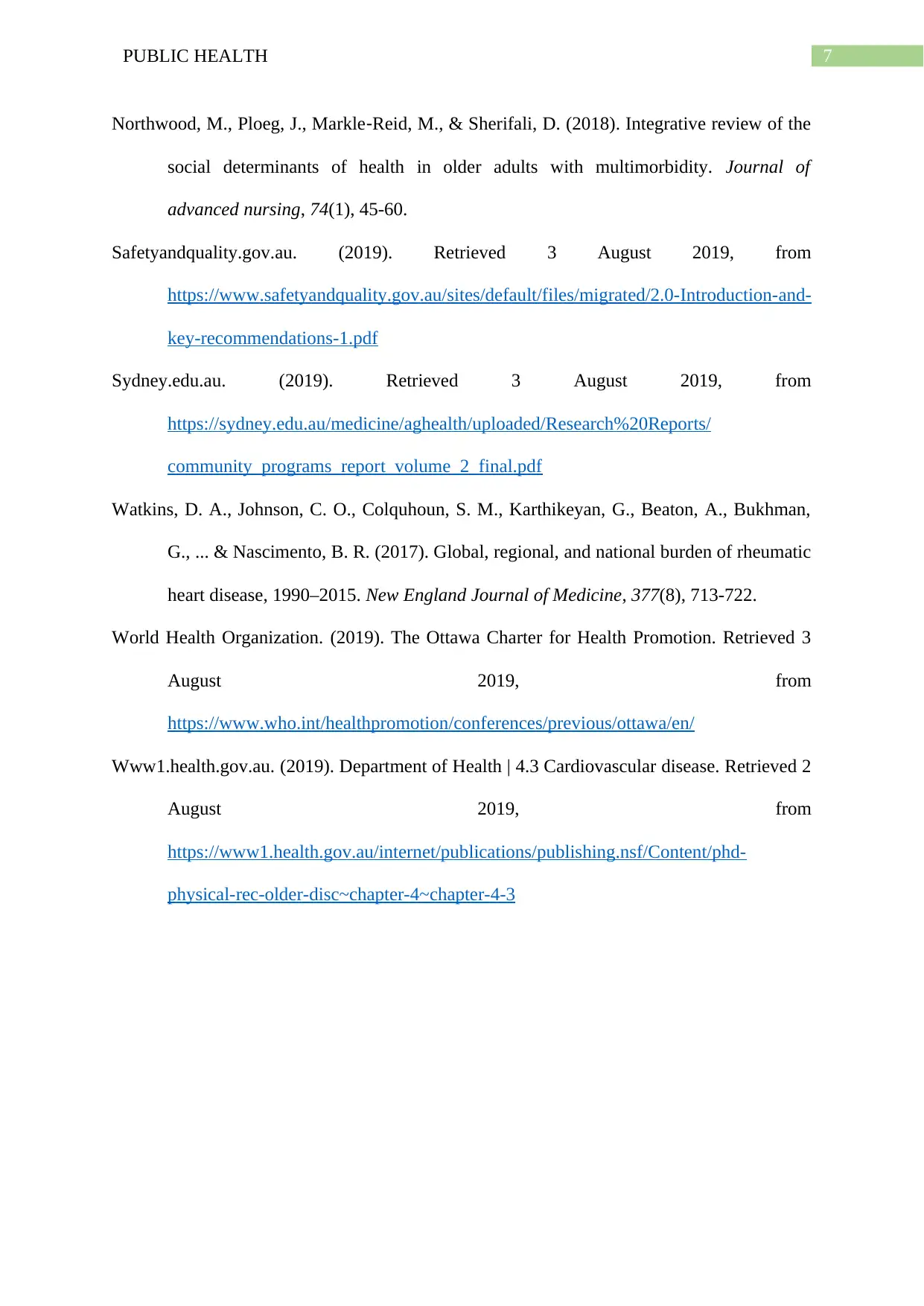
7PUBLIC HEALTH
Northwood, M., Ploeg, J., Markle‐Reid, M., & Sherifali, D. (2018). Integrative review of the
social determinants of health in older adults with multimorbidity. Journal of
advanced nursing, 74(1), 45-60.
Safetyandquality.gov.au. (2019). Retrieved 3 August 2019, from
https://www.safetyandquality.gov.au/sites/default/files/migrated/2.0-Introduction-and-
key-recommendations-1.pdf
Sydney.edu.au. (2019). Retrieved 3 August 2019, from
https://sydney.edu.au/medicine/aghealth/uploaded/Research%20Reports/
community_programs_report_volume_2_final.pdf
Watkins, D. A., Johnson, C. O., Colquhoun, S. M., Karthikeyan, G., Beaton, A., Bukhman,
G., ... & Nascimento, B. R. (2017). Global, regional, and national burden of rheumatic
heart disease, 1990–2015. New England Journal of Medicine, 377(8), 713-722.
World Health Organization. (2019). The Ottawa Charter for Health Promotion. Retrieved 3
August 2019, from
https://www.who.int/healthpromotion/conferences/previous/ottawa/en/
Www1.health.gov.au. (2019). Department of Health | 4.3 Cardiovascular disease. Retrieved 2
August 2019, from
https://www1.health.gov.au/internet/publications/publishing.nsf/Content/phd-
physical-rec-older-disc~chapter-4~chapter-4-3
Northwood, M., Ploeg, J., Markle‐Reid, M., & Sherifali, D. (2018). Integrative review of the
social determinants of health in older adults with multimorbidity. Journal of
advanced nursing, 74(1), 45-60.
Safetyandquality.gov.au. (2019). Retrieved 3 August 2019, from
https://www.safetyandquality.gov.au/sites/default/files/migrated/2.0-Introduction-and-
key-recommendations-1.pdf
Sydney.edu.au. (2019). Retrieved 3 August 2019, from
https://sydney.edu.au/medicine/aghealth/uploaded/Research%20Reports/
community_programs_report_volume_2_final.pdf
Watkins, D. A., Johnson, C. O., Colquhoun, S. M., Karthikeyan, G., Beaton, A., Bukhman,
G., ... & Nascimento, B. R. (2017). Global, regional, and national burden of rheumatic
heart disease, 1990–2015. New England Journal of Medicine, 377(8), 713-722.
World Health Organization. (2019). The Ottawa Charter for Health Promotion. Retrieved 3
August 2019, from
https://www.who.int/healthpromotion/conferences/previous/ottawa/en/
Www1.health.gov.au. (2019). Department of Health | 4.3 Cardiovascular disease. Retrieved 2
August 2019, from
https://www1.health.gov.au/internet/publications/publishing.nsf/Content/phd-
physical-rec-older-disc~chapter-4~chapter-4-3
1 out of 8
Related Documents
Your All-in-One AI-Powered Toolkit for Academic Success.
+13062052269
info@desklib.com
Available 24*7 on WhatsApp / Email
![[object Object]](/_next/static/media/star-bottom.7253800d.svg)
Unlock your academic potential
Copyright © 2020–2025 A2Z Services. All Rights Reserved. Developed and managed by ZUCOL.





